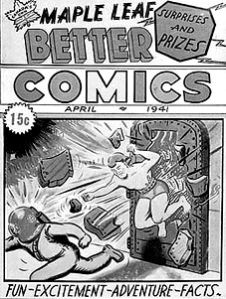
Cover art by Ley Fortune.
There’s often a lot of focus on Bell Features for their contribution to the Canadian comic book industry, and rightly so. The company published hundreds of comics under several titles during the crucial years of comic book development in Canada. Not necessarily overlooked, but perhaps not looked upon as often as they should be, are the publishings of another founding father of Canadian comics, Maple Leaf Publishers.
Along with Anglo-American, Maple Leaf was one of the first to publish and release comics in Canada. While I try not to express too much favouritism, I do agree with John Bell in that it was the first true Canadian comic, as Anglo American evaded the wartime ban on American periodical publications by purchasing scripts. Maple Leaf’s first issue was Better comics, released March of 1941 in the Canadian tradition of black and white interior with colour covers.

Second issue of Better Comics
Maple Leaf’s line of comics included Better, Bing Bang, Lucky and Rocket comics. Most were released regulary on a bi-monthly basis from 1941 to 1946. They also wasted no time in producing a Canadian hero, and again, the first in Canada, which was Vernon Miller’s Iron Man in Better Comics. Later Maple Leaf produced the more famous Brok Windsor who came out in the April May 1944 issue of Better Comics.
Some of the other more regular comics published in the anthologies’ titles were The Exciting Adventures of Peter and Peggy, Coast Patrol, The Adventures of Lucky, Derry Dreamer, Black Wing, Juke Box Joe, Piltdown Pete, Deuce Granville, Cariboo Trail, Rags the Dog Marvel, Callahan, Cosmo and his White Magic, The Honourable Freddy, Bill Speed, Stuffy Boggs, Circus Girl and Senorita Marquita. One benefit to having several lines as Bell did was that he could cater to different audiences depending on the book. Maple Leaf’s stories spanned several genres but were contained within four books.
That said, one argument certainly true of Maple Leaf Comics is that they had some quality artists on staff. Some of my own favourite Golden Age artists worked for Maple Leaf such as Bert Bushell, Jon Stables (St. Ables) and Vernon Miller. Other artists included Ernie Walker, Shirley “Ley” Fortune, Ray Hazall, Bill Meikle, Bill Benz, Vim Pearson, Spike Brown, Ted Watson, FP Thursby and Herb Brew with writers such as Hall, FP Thursby, Hal Kerr, Bus Griffiths and Ted Ross. A smaller staff than Bell Features, Maple Leaf had the benefit of having a more consistent product. And, although Bell Features owner Cyril Bell created something great with Bell features, many of his own artists were either in, or fresh out of high school and were therefore very young, amateur artists.
But, like many of the publishers that sprang up at the beginning of the forties, Maple Leaf ceased publishing in 1946 when the War Exchange Conservation Act was lifted.
